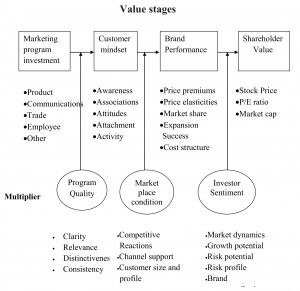Brand Value chain
Brand value chain is a structured approach to assessing the sources and outcomes of brand equity and the manner by which marketing activities create brand value.
It provides insights to support the various decision makers in the company and stresses that every member of the company contribute to this branding effort. It believes that the value of rand ultimately resides with customers.
The Brand Value Chain is a model constructed in 2003 by Keller and Lehmann. The Brand Value Chain helps marketers track brand value from the first stage of a marketing investment to the final stage of shareholder value.
Stages
1. Marketing Program Investment
The marketing programme element deals with those efforts in which brand-owning firms take to influence their brand. It can deal with products that are offered under the brand name as well as pricing, channel decisions (place), and promotion.Marketing Program Investment is any marketing program investment that potentially can impact brand value, intentionally or not. This link in the model includes product research and development as well as product design. Secondly, all investments in communications are included, such as advertising, promotion, sponsorships, publicity and public relations and thirdly, investments in trade or intermediary support. The fourth example of a marketing program investment that can affect brand value are all investments in employees, this includes selection, training, and support. A marketing program investment can be a commercial or a sponsorship.
2. Customer Mindset
Customer mindset is the second stage and includes everything that happens in the minds of the consumers in respect to the brand: thoughts, feelings, experiences, beliefs, and attitudes. As stated, importance of the brand to the customer is referred to by brand equity. The customer mindset includes associations linked to the brand in a customer’s memory, or “everything that exists in the minds of customers with respect to a brand (e.g. thoughts, feelings, experiences, images, perceptions, beliefs and attitudes. Because brand value ultimately relies with the customers, this stage will be the focus for this research, and will be the instrument used to compare Nike and adidas in this thesis. Customer mindset is the only stage in the value chain that fully focuses on the consumer, making it the stage where brand equity is best measured and created.Five elements, or dimensions, came forth from previous research as primary measures for the customer mindset:
- awareness
- associations
- attitudes
- attachment
- activity
There is an explanation why the five dimensions are ranked this way. Awareness supports associations, which drive attitudes that lead to attachment and activity.This means that a high level of awareness creates brand value in this stage.Customer mindset can be assessed by customer surveys.
- Brand Awareness
The first factor is brand awareness. How well can customers recognize the brand and the products made by the brand? What company do consumers view as the leader in a particular market? Recognizing the brands means identifying various brand elements, e.g brand name, logo, symbol, character, packaging, and slogan. Brand awareness features depth and breadth . The depth of brand awareness relates to what extend a brand is recognized or recalled. The breadth of brand awareness relates to the variety of situations a brand comes to mind when purchasing a product.
- Brand Associations
The second element is brand associations, which considers the strength, favourability, and uniqueness of perceived attributes and benefits for the brand. Associations are descriptive thoughts that a person holds about something. For example, consumer have brand associations for Apple such as “Mac and iPod,” “Cool and Awesome,” “Design and Innovative,” and “Expensive and Computer” . Brand associations are formed with advertisements, word of mouth publicity, quality of the product, celebrity associations, and point of purchase displays.


